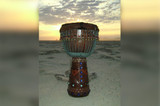The Toca Conga Difference
With origins from African and Cuban traditions, conga drums are probably the most popular hand drums today. Made from a variety of wood or from fiberglass, congas are available in different shapes and sizes.
Here are just a few features that set Toca Congas apart from other brands and create the "Toca Difference" and unmistakable Toca look and sound.
Toca Heads:
Toca conga heads are 1st quality bison skins that are graded and sorted by thickness for each particular size drum. This grading process ensures the best tonal response from each different sized drum. All Toca heads are tucked rather than sewn to prevent "pull out" and are mounted wet, to assure the best contact (or seat) between the bearing edge and the head.
Toca Hoops:
Toca offers two very different types of hoops for our professional series congas. Toca hoops are composed of thick metal allowing more rigidity to the hoop and even tension at all points.
- Toca's Traditional-Style Hoop is found on the 3900 Traditional Series drums and features lightweight construction to "free up" sound. This Traditional hoop holds the head close to the shell and gives the drum a more authentic Cuban sound.
- Toca's Exclusive "Easy Play" Hoop was designed with a very low collar to keep the hoop away from possibly injuring the player's hand. Toca's Easy Play hoop also stretches the conga head over the bearing edge of the drum to increase the resonance and tone. These hoops are constructed from top grade, 3 mm thick steel then plated to a high gloss finish.
- Toca's Player's Easy Play Style Hoop performs much like our professional model by giving added protection to the player and is 2.6mm thick to give that added strength.
Toca Shell Construction:
All Toca wooden shells are constructed from slats of Asian Oak hardwood. Two wood slats are glued together to form a very strong stave. The wood staves are then formed into a shell that can hold its shape indefinitely. The double-ply shell construction combined with the process of finishing the inside of the shell help to make the drums light in weight and very resistant to changing weather conditions.
Toca Shell Shape:
The shape of the drum bowl determines the tonal characteristics of a particular style or brand of drum. Toca uses two different bowl shapes, the "Traditional Afro-Cuban" shape and the "Contemporary Afro-Cuban" style bowl.
- Traditional Afro-Cuban bowl shape has a very sharp taper at the bottom of the shell. This creates a strong bass tone in the drum, which is the "Afro-Cuban" sound that many Latin players prefer.
- Contemporary Afro-Cuban bowl shape has a larger belly and less taper than its Afro-Cuban counterpart with a much bigger hole at the bottom of the drum. This shape produces more volume with less effort. The Contemporary bowl shape (more volume with less effort) coupled with the easy play hoop (more resonance) makes this drum ideal for most live playing situations where extra volume is needed.
Toca Tuning Hardware:
The tuning hardware, coupled with the hoop, is what holds the head on the drum and keeps it in tune.
- The Tension Plate is at the heart of this process and takes the brunt of the abuse in keeping the drum in tune. Because of the enormous amount of pressure placed on the drum bowl during tuning and playing, Toca has designed all of their drums with an exclusive 4-bolt tension plate. This helps spread the tension over the entire shell making the tuning more stable and preventing tension plate "pull-out" or "cave in" that occurs on some drums as a result of the constant pressure.
- The Tension rods, which connect the hoop to the Tension plate, are made of hardened steel to prevent bending when the drums are tuned to a high pitch. The rods are held away from the shell with a special cup washer that not only aids in the ease of tuning, but also helps prevent the wrench from damaging the tension plate and the shell.
Recent Posts
-
What is the Best Size Djembe for Beginners?
If you're new to the world of percussion and interested in learning the djembe, you're in for a t …16th Jul 2024 -
The Benefits of Becoming a Drumming Teacher: Transforming Passion into Profession
Why become a drumming teacher? Becoming a drumming teacher is an excellent way to share your pas …22nd May 2024 -
What Makes the Djembe Drum a Spiritual Instrument in African Music?
Origin and history of the Djembe drum The Djembe drum originates from West Africa and holds sign …16th May 2024



